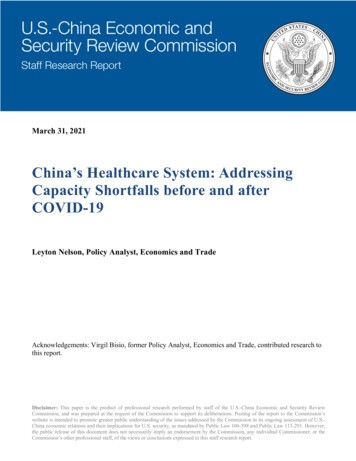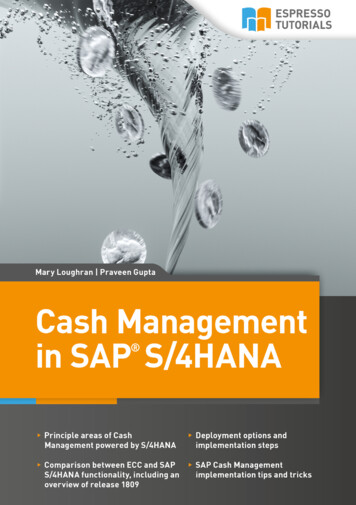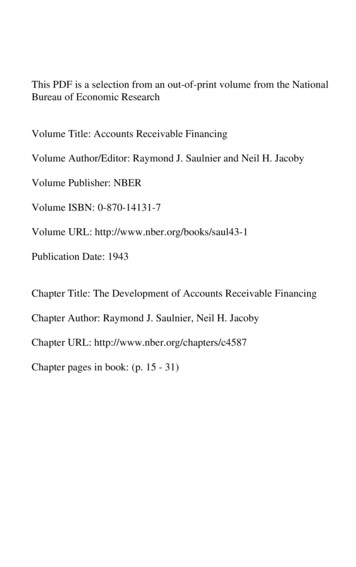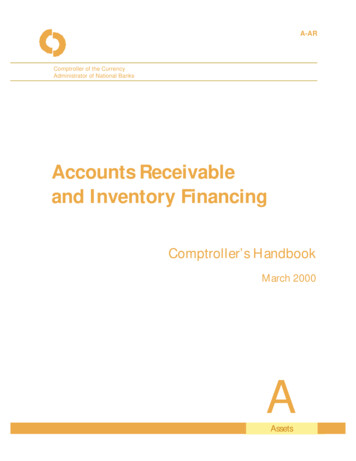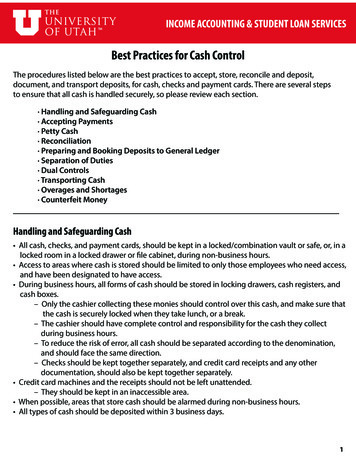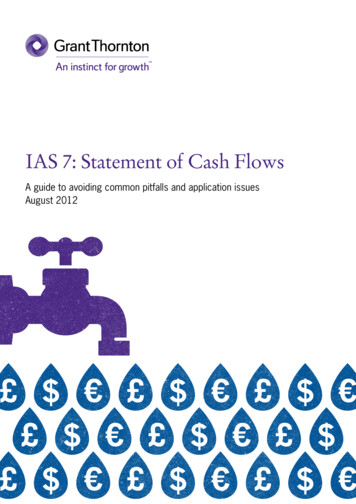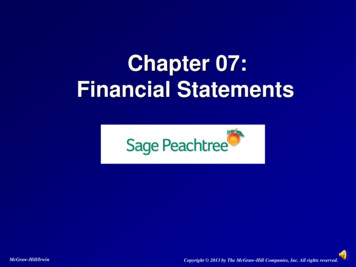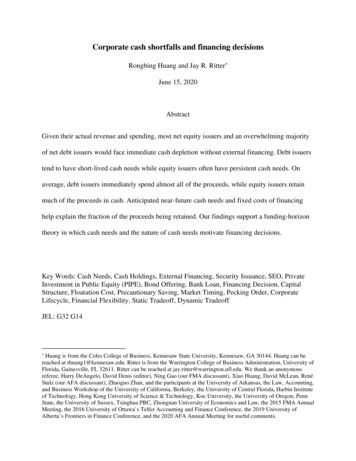
Transcription
Corporate cash shortfalls and financing decisionsRongbing Huang and Jay R. Ritter June 15, 2020AbstractGiven their actual revenue and spending, most net equity issuers and an overwhelming majorityof net debt issuers would face immediate cash depletion without external financing. Debt issuerstend to have short-lived cash needs while equity issuers often have persistent cash needs. Onaverage, debt issuers immediately spend almost all of the proceeds, while equity issuers retainmuch of the proceeds in cash. Anticipated near-future cash needs and fixed costs of financinghelp explain the fraction of the proceeds being retained. Our findings support a funding-horizontheory in which cash needs and the nature of cash needs motivate financing decisions.Key Words: Cash Needs, Cash Holdings, External Financing, Security Issuance, SEO, PrivateInvestment in Public Equity (PIPE), Bond Offering, Bank Loan, Financing Decision, CapitalStructure, Floatation Cost, Precautionary Saving, Market Timing, Pecking Order, CorporateLifecycle, Financial Flexibility, Static Tradeoff, Dynamic TradeoffJEL: G32 G14Huang is from the Coles College of Business, Kennesaw State University, Kennesaw, GA 30144. Huang can bereached at rhuang1@kennesaw.edu. Ritter is from the Warrington College of Business Administration, University ofFlorida, Gainesville, FL 32611. Ritter can be reached at jay.ritter@warrington.ufl.edu. We thank an anonymousreferee, Harry DeAngelo, David Denis (editor), Ning Gao (our FMA discussant), Xiao Huang, David McLean, RenéStulz (our AFA discussant), Zhaoguo Zhan, and the participants at the University of Arkansas, the Law, Accounting,and Business Workshop of the University of California, Berkeley, the University of Central Florida, Harbin Instituteof Technology, Hong Kong University of Science & Technology, Koc University, the University of Oregon, PennState, the University of Sussex, Tsinghua PBC, Zhongnan University of Economics and Law, the 2015 FMA AnnualMeeting, the 2016 University of Ottawa’s Telfer Accounting and Finance Conference, the 2019 University ofAlberta’s Frontiers in Finance Conference, and the 2020 AFA Annual Meeting for useful comments.
1. IntroductionFirms do external financing for a variety of reasons. They may need cash to fundinvestment or operations. Debt or equity issuance may also be motivated by a desire to rebalancecapital structures or increase cash balances. In this paper, we find that external financingdecisions of U.S. firms during 1972-2013 are primarily motivated by near-term cash shortfalls,with the choice of financing instrument determined by how persistent the cash shortfalls are andwhat the issuance proceeds will be used for.1 By contrast, moving towards a stationary targetcapital structure appears to be a second-order consideration for most companies. Our findingssuggest that observed capital structures are best explained by a dynamic tradeoff model with pathdependent outcomes of period-by-period financing decisions.The pecking order theory (Myers (1984)) and the market timing theory (Baker andWurgler (2002)) are theories of optimized security issuance, in which the firm’s debt ratio ismerely the path-dependent outcome of these period-by-period decisions. These theories assumethat the tradeoff between the tax advantage of debt financing and financial distress costs isunimportant, and have limited empirical support. The static tradeoff theory, on the other hand, isa theory of capital structure optimization that encounters substantial difficulty in explaining slowspeeds of adjustment and frequent occurrences of security issuances that move a firm away fromits target. DeAngelo and Roll (2015) document that capital structures exhibit significantinstability from decade to decade, inconsistent with theories in which staying close to a particulartarget debt ratio is of primary importance.1In this paper, a firm’s cash shortfall or cash need in a fiscal year is measured by its net spending in the year minusthe sum of its beginning-of-year cash balance and internal cash flow in the year. A firm that has a cash shortfall isnot necessarily in financial trouble. Cash needs in fiscal year t are viewed as immediate cash needs. Fiscal years t 1and t 2 are viewed as near-future and medium-future, respectively, and both t and t 1 are viewed as near-term.1
A dynamic tradeoff model, which incorporates both security issuance optimization andcapital structure level optimization associated with meeting immediate and future funding needs,as in DeAngelo, DeAngelo, and Whited (2011), henceforth DDW, appears to offer the greatestability to describe capital structures. In their model, a firm issues debt to meet short-livedfunding needs associated with imperfectly anticipated investment shocks, even if it results in adebt ratio that is temporarily above the firm’s long-run target. If firms anticipate sufficientlylarge future funding needs, they forego borrowing and instead issue costly equity to meet animmediate funding need. In their model, a firm’s target debt ratio is the debt ratio to which thefirm would converge after many periods of neutral investment shocks. Firms have target debtratios that are low because they want to maintain unused debt capacity, so as to be able to fundprofitable investment opportunities in the future.In this paper, we provide empirical evidence describing security issuance behavior. Weaddress three questions on the importance of cash needs for financing decisions. First, given theiractual revenue and spending, do U.S. firms that engage in external financing do so mainly whenthey would otherwise run out of cash either immediately or in the near-future? The answer is yes.Given their actual revenue and spending, without external financing, 75.0% of firms with netdebt issuance and 53.9% of firms with net equity issuance would have otherwise run out of cashby the end of the year of issuance.2 By the end of the following year, 83.2% of firms with netdebt issuance and 72.5% of firms with net equity issuance in a year would otherwise have runout of cash. In our multinomial logit regressions, measures of near-term cash needs based onactual revenue and spending dominate other firm characteristics in predicting the decision toraise external debt or equity capital. If they didn’t raise money, however, firms might spend less.2Unless explicitly stated as otherwise, “equity issuance” and “net equity issuance” are used interchangeably, as are“debt issuance” and “net debt issuance”.2
Measures of immediate cash needs based on projected revenue and spending, for whichendogeneity issues are less of a concern, are also strongly related to net issuance. These findingssuggest that a near-term cash shortfall rather than pure cash stockpiling or leverage rebalancingis the primary motive for net debt or equity issuance.Second, is the nature of cash needs (i.e., how persistent cash needs are and how theproceeds are used) very important for the choice between debt and equity financing? Some typesof firms (e.g., unprofitable and R&D-intensive firms) tend to have multi-year cash needs whileothers types of firms tend to have short-lived cash needs. Unprofitable firms frequently continueto be unprofitable in subsequent years, as documented by Denis and McKeon (2020). Amongfirms that would otherwise face immediate cash depletion, given their actual revenue andspending, the likelihood of net equity issuance in a year is 18.3% for profitable firms andincreases substantially to 48.2% for unprofitable firms, while the likelihood of net debt issuancedecreases from 70.1% for profitable firms to 53.2% for unprofitable firms. These likelihoods arenot very sensitive to whether current or lagged values of profitability are used. Furthermore,small, growth, and R&D-intensive firms are more likely to issue equity rather than debt. Thesepatterns suggest that firms with immediate and short-lived investment spending prefer debtissuance. By contrast, equity issuance is preferred by firms with long-lived cash needs, as wheninvesting in research and development (R&D), which often produces persistent operating lossesand does not quickly result in pledgeable assets (i.e., assets that can be used as collateral).Third, what proportion of the proceeds is retained as cash at the end of the fiscal year inwhich the net issuance occurs? Because net debt or equity proceeds are positively associatedwith both the growth of non-cash assets in the issuance year and the expected level of cash needsin the near future, it is plausible to expect a positive relation between the proceeds and the3
change in cash. More cash may be needed to accompany the growth of other assets, and largeexpected near-future cash needs incentivize issuers to raise extra proceeds and thus create a cashreserve to avoid the fixed costs of raising capital again soon. Compared with debt issuers, equityissuers often have characteristics that are associated with longer-lived (more persistent) cashneeds, have less pledgeable assets for future borrowing, and are less likely to have a credit line todraw on for future cash needs. Furthermore, the fixed costs of issuing equity are typically higherthan those of issuing debt, and the terms of equity issuance can fluctuate more substantiallyacross time than the terms of debt issuance, providing an incentive to issue equity and stockpilecash in good times. Consistent with the above discussions, our regression analysis shows that anextra dollar of net debt or equity proceeds in a fiscal year is associated with, respectively, anincrease of 18.9 cents or 62.9 cents in cash reserves at the end of the year. The retention rate of62.9 cents per dollar does not necessarily mean that pure cash stockpiling (i.e., increasing cash toan abnormally high level) is the primary use of equity proceeds, because many equity issuersneed more cash to accompany their non-cash asset growth and/or fund expected near-future cashneeds. Much of the proceeds is only temporarily parked in the cash reserve.Issuing equity in the public market normally has higher fixed costs than placing shares inthe private market. The fixed costs of drawing on a credit line are presumably lower than thosefor other types of external debt financing. A large cash increase is expected when the fixed costsof financing are large. Consistent with these expectations, in one regression that controls forother determinants of cash changes, the fraction of net equity proceeds going to cash reserves inyears when there is a seasoned equity offering (SEO), also known as a follow-on, is 8.1% higher(e.g., 68.1% versus 60.0%) than in years when there is a Private Investment in Public Equity(PIPE) transaction. In another regression, in years when there is a public bond offering, the4
fraction of net debt issuance going to cash reserves is 18.6% higher than in years with a newcredit line arrangement, after controlling for other variables.Our paper builds on two papers on near-term cash needs and the decision to raise capital.DeAngelo, DeAngelo, and Stulz (2010), henceforth DDS, find that 62.6% of firms conductingSEOs from 1973-2001 would have run out of cash by the end of the following year if they didnot raise capital. Our paper documents similar results for a comprehensive sample of equityissues, including SEOs. Denis and McKeon (2012) document that, for the subsets of their sampleof 2,314 firm years with large leverage increases from 1971-1999, the likelihood of immediatecash depletion ranges from 70.8% to 93.4%. We document similar results for a much largersample of debt issues than theirs. We also extend these two papers to address 1) why some firmsissue debt while others issue equity to fund immediate cash needs, and 2) whether firms thatissue debt or equity raise just enough capital to avoid immediate cash depletion.Although external financing is common, many papers document a relatively moderatespeed of adjustment toward target leverage (e.g., Huang and Ritter (2009), Iliev and Welch(2010), and Yin and Ritter (2019)). Our findings help explain how a moderate speed ofadjustment and extensive external financing can coexist. Firms issue debt or equity primarily formeeting immediate cash needs rather than engaging in capital restructurings to move towardstarget leverage. As the DDW model predicts, firms with immediate and short-lived cash needsthat issue debt instead of equity may become over-levered relative to their stationary targets. Incontrast, firms with long-lived cash needs issue equity instead of debt to fund immediate cashneeds even if they become under-levered, partly because they are concerned about theopportunity costs of failing to fund future cash needs. Existing research finds that many5
profitable firms that have low leverage do not issue debt (Graham (2000)). Our findings suggestthat this pattern is partly because these firms do not have an immediate need for external capital.McLean (2011) suggests that precautionary cash savings have become the primary use ofshare issuance proceeds. He finds that most of the equity issuance proceeds are used to increasecash reserves, especially for R&D-intensive firms, firms in industries with high cash flowvolatility, and firms that do not pay dividends. We show that many of these firms have long-livedcash needs. Thus, besides precautionary savings demand, high expected levels of future cashneeds and large fixed costs of equity financing can also explain why the positive relationbetween net equity proceeds and cash changes is so strong. We further contribute to the literatureby showing that the positive relation is stronger when there is public financing than when there isprivate financing, consistent with explanations based on fixed costs of financing.Our paper complements that of Denis and McKeon (2020). Our paper emphasizes theimportance of cash needs and the nature of cash needs for the decision to raise external capital,the choice between debt and equity financings, and the decision on how much of the proceeds isretained as cash. Their paper documents that within our sample period Compustat-listed firmswith persistent funding needs have become more common, and that these firms account for mostof the growth in average cash balances of U.S. firms. They also document that the growth inaverage cash balances is most prominent in firms with both negative net cash flows and intensiveintangible investment. They show that the high cash balances for many of these firms areassociated with equity financing, with the high cash balances quickly decreasing due tosubsequent negative net cash flows. Both papers emphasize that equity financing is common forfirms with persistent funding needs.6
Our paper contributes to a growing literature on the importance of cash needs forfinancing decisions (DDS, McLean (2011), Denis and McKeon (2012, 2020), and McLean andPalazzo (2018)). Our findings provide strong support for a funding-horizon theory of financingdecisions based on the DDW model. This theory posits that financing decisions are primarilymotivated by cash needs and the nature of cash needs. In this theory, firms do external financingwhen they have an immediate cash need. Firms with temporary (short-lived) cash shortfallscaused by investing in tangible assets or transitory losses issue debt, and firms with persistent(long-lived) cash shortfalls caused by R&D spending or persistent operating losses issue equity.In this theory, attaining target leverage is not a primary motive for financing decisions. As aresult, observed capital structures are path dependent.2. A Conceptual Framework for Financing Decisions2.1 The costs and benefits of external financingFirms consider all sorts of benefits and costs when making financing and investmentdecisions. Traditional capital structure theories focus on the tax benefits of debt, financialdistress costs, issuance costs, information asymmetry costs, or market timing benefits, or acombination of them. In comparison, the funding-horizon theory of financing decisions considersthese costs and benefits, but emphasizes the opportunity costs of not meeting cash needs.The opportunity costs of not meeting cash needs include the costs of forgoing or delayingpositive net present value (NPV) projects, the costs of selling assets to raise cash, the costs offailing to meet operating cash needs, and the costs of failing to retain existing employees orattract new employees. The opportunity costs of not meeting cash needs are not the same as thetraditional view of bankruptcy costs. Even if a firm has no debt at all or is unlikely to gobankrupt, without thoughtful financing plans, it could incur large opportunity costs of underspending on investment or operations. Holding more cash reduces the opportunity costs of cash7
depletion, but it increases the opportunity and agency costs of holding cash. Thus, many firmsrely on external financing, in addition to cash holdings, to fund investment or operational needs.In the static tradeoff theory, firms choose an optimal debt ratio by comparing the taxbenefits and financial distress costs of debt. If the costs of leverage deviations are sufficientlylarge, firms engage in capital restructurings (i.e., issuing debt to repurchase equity or issuingequity to retire debt) to move towards target leverage, even if they have no immediate cashneeds.Dynamic tradeoff models assume that floatation costs slow down the speed of adjustmenttoward target leverage (e.g., Fischer, Heinkel, and Zechner (1989)). There are several differenttypes of dynamic tradeoff theories, as surveyed by Ai, Frank, and Sanati (2020), includingmodels with exogenous investment and those with endogenous investment due, for instance, todebt overhang issues. This second set of models focuses on the value of financial flexibility.Our funding-horizon theory of financing decisions is based on the dynamic model inDDW. In their infinite-period model, firms make investment and financing decisions at eachdate. When firms issue debt to fund investment shocks, they may deliberately and temporarilymove away from their targets. A firm’s target debt ratio exists in a long-run sense and preparesthe firm optimally for raising capital in the future. Their model considers investmentopportunities, taxes, distress costs, external financing costs, and the costs of holding cash, withfinancial flexibility for funding investment opportunities being an important consideration.There is a key difference between the DDW dynamic tradeoff model/funding horizontheory of security issuance and traditional dynamic tradeoff models. The traditional modelspredict that, other than to save on transaction costs, when firms issue securities, they will issuesecurities that move them towards their target debt ratios. In contrast, the funding-horizon theory8
based on the DDW model accommodates financing-induced leverage deviations and predicts thatsecurity issuance normally occurs when a company is running out of cash, and that the type ofsecurity issued is determined mainly by the expected persistence of external funding needs.2.2 The decision to raise external capital: the importance of immediate cash needsDynamic tradeoff models with fixed costs of financing and exogenous investmentgenerally predict that security issuance occurs when a firm’s debt ratio moves far enough awayfrom the firm’s target that it is worthwhile to incur the transaction costs. In contrast, the fundinghorizon theory assumes that the advantage of moving to the target is sufficiently small that mostof the time it is not worthwhile to issue securities until a firm is running out of cash, at whichpoint it must either raise external capital, sell assets, cut spending, or forego investment. When afirm does raise capital, the amount of capital raised depends on the magnitude of funding needsand transaction costs. If the fixed costs are low, as with a bank line of credit or an at-the-market(ATM) equity offering, the amount of capital raised will be small. If cash needs are persistent,capital raising events will be frequent. If the fixed costs are high, capital raising events will beless frequent, and in larger amounts when they occur. Transaction costs may be high eitherbecause of fees, because of adverse selection costs (as in the pecking order theory), or because oftime-varying mispricing (as in the market timing theory).2.3 The debt versus equity choice: the importance of the nature of cash needsThe funding-horizon theory of financing decisions, which emphasizes cash needs and thenature of cash needs, can help explain not only the decision to raise external capital, but also thechoice between debt and equity. Firm characteristics such as profitability and the type ofinvestment determine the nature of cash needs. Denis and McKeon (2020) document that cash9
needs due to operating losses and/or R&D spending are more persistent than those due tospending on tangible assets.Debt provides tax benefits and has low floatation costs, and the availability of pledgeableassets can further reduce the cost of debt. However, the funding-horizon theory further positsthat, for firms with long-lived cash needs, these benefits of debt can be less important than theopportunity costs of failing to meet the cash needs, resulting in an incentive to preserve debtcapacity. As DDW emphasize, having too much debt removes the option of issuing more debt ifthere is limited debt capacity.Debt financing can be less costly than equity financing for firms with immediate andshort-lived cash needs, especially when the needs are due to investment in tangibles rather thanthe funding of operating losses. As in the static tradeoff model, the after-tax cost of debt is lowfor firms that are expected to be persistently profitable. These firms issue debt even if doing sosometimes makes them over-levered relative to their long-term targets. Following debt issuance,they can gradually pay off the debt with internally generated funds when they no longer havelarge cash needs. DDW and DeAngelo and Roll (2015) suggest that this behavior is common.Long-lived cash needs usually arise from persistent operating losses or projects thatrequire many years or rounds of large investments in intangible, non-pledgeable assets, requiring“permanent capital.” Many firms have a negative operating cash flow because of large R&Dexpenses (e.g., paying research scientists), which may not quickly result in pledgeable assets. Itcan be very expensive for firms with long-lived cash needs to issue debt. Even if they are able toissue debt at a reasonable cost to fund immediate cash needs, issuing equity rather than debt canbe optimal. Unused debt capacity is a valuable source of financial flexibility (Denis (2011),DDW, and DeAngelo, Goncalves, and Stulz (2018)). Issuing debt instead of equity to fund10
immediate cash needs can lower floatation costs and taxes in the current year, but with thedisadvantage of increasing future floatation costs, bankruptcy costs, and the opportunity costs ofa reduced ability to fund future cash needs. For companies with losses that are expected topersist, the tax advantage of debt financing is not present in the near future, making an equityissue more attractive.2.4 The relative advantages of the funding-horizon theory of financing decisionsGiven the tax benefits of debt, traditional tradeoff theories that ignore the benefits ofmeeting cash needs and floatation costs can also explain why profitable firms are more likely toissue debt rather than equity, conditional on raising external capital. These theories, however,cannot easily explain the widely documented negative relation between profitability andleverage, and why many profitable firms without immediate cash needs do not issue debt.Furthermore, as DDW and Denis and McKeon (2012) note, traditional tradeoff models also havedifficulty in explaining a very modest speed of adjustment towards target leverage and whymany firms move away from target leverage when they issue debt. These patterns, however, areconsistent with the funding-horizon theory of financing decisions.The pecking order model of Myers (1984) emphasizes information asymmetry costsrather than the opportunity costs of not meeting cash needs. Frank and Goyal (2003) suggest thata major challenge for the pecking order theory is to explain why small growth firms, which facehigh information asymmetry, are more likely to issue equity instead of debt than are large valuefirms. Our evidence suggests that the reason is that small growth firms tend to have longer-livedcash needs and thus face larger opportunity costs of cash depletion than large value firms,consistent with the funding-horizon theory of financing decisions. Furthermore, many small11
growth firms are unprofitable and would not get immediate tax benefits from issuing debt, if theycould issue debt at all.Using the market-to-book ratio as a proxy for market timing opportunities, Baker andWurgler (2002) present evidence that observed capital structure is the outcome of past attemptsto time the equity market. Because market-to-book ratios are correlated with cash needs and howlong-lived the needs are, their evidence is also consistent with the funding-horizon theory offinancing decisions.32.5 The fraction of issuance proceeds being used to increase cash reserves: an explanationbased on expected near-future cash needs and fixed floatation costsThe funding-horizon theory of financing decisions can also help explain the relationbetween net issue proceeds and cash changes. Net issue proceeds are positively related to thechange in non-cash assets and near-future cash needs. When a firm’s non-cash assets increase, ittypically needs higher cash balances for working capital. Furthermore, in the presence of largefixed equity floatation costs, firms with long-lived cash needs have an incentive to raise enoughcapital to fund immediate cash needs and create a cash reserve for expected cash needs in thenear future. Therefore, a positive relation between net issue proceeds and cash changes isexpected, especially for equity issuers. Many equity issuers, especially those that have high R&Dspending and/or high Tobin’s Q, have high expected levels of future cash needs and thustemporarily increase cash substantially. A high retention rate of equity proceeds does notnecessarily result in an abnormally high cash level or pure cash stockpiling. As Denis andMcKeon (2020) document, equity issuers with persistent cash needs frequently display a zig-zagtime-series pattern with their cash balances.3Jung, Kim, and Stulz (1996) provide an agency explanation for the positive relation between growth opportunitiesand equity issuance.12
3. Data, summary statistics, and univariate sorts3.1. DataWe use Compustat to obtain financial information and CRSP to obtain stock prices foreach U.S. firm. We require the statement of cash flow information for fiscal years t and t-1.Since the cash flow information is only available from 1971, our sample starts from 1972. Sincewe also examine stock returns from t 1 to t 3, our sample ends at 2013. We also drop firm-yearobservations for which frequently used variables in our paper have a missing value, the net salesis not positive (thus excluding many biotech firms), the book value of assets or the market valueof equity at the end of fiscal year t-1 is less than 10 million (expressed in terms of purchasingpower at the end of 2010), the book value of assets at the end of t-2 is missing, the cash flowidentity is violated in t and t-1, or there is a major merger in t.4 To avoid the effect of regulationson financing decisions, we remove financial and utility firms from our analysis.In this paper, a firm is defined as having a net debt or net equity issuance in a fiscal yearif, respectively, its net debt or net equity proceeds in the year from the cash flow statement are atleast 5% of the book value of assets and 3% of the market value of equity at the beginning of theyear. McKeon (2015) reports that a 3% of market equity screen removes from the equity issuecategory almost all firm-years with only stock option exercises. The equity issuance proceedsinclude cash from SEOs, PIPEs, employee stock option exercises, and preferred stock issuances.5The debt issuance proceeds include cash from straight and convertible bond offerings and bankfinancings. Technically, bank loans do not involve security issuance, but for convenience we4A violation of the cash flow identity in year t occurs when the absolute value of the difference between the usesand sources of funds in year t is greater than 0.5% of Assetst-1. A major merger is identified by the Compustatfootnote for net sales being AB, FD, FE, or FF. Our data requirements result in the dropping of firms that solvedtheir cash shortfall problems by being acquired during year t.5Since we require a one-year stock return prior to the current fiscal year, initial public offerings (IPOs) and SEOsshortly after the IPO are not included in our sample. Because cash flow statements are used, stock-financedacquisitions are not counted as equity issuances.13
refer to the money raised from a bank loan as issuance proceeds. The final sample for most ofour analysis consists of 124,058 firm-year observations from 1972-2013, including 13,152 firmyears with net equity issuance and 26,324 firm-years with net debt issuance.3.2. Summary statistics and univariate sortsPanel A of Table 1 reports the sample distribution by financing category. A net debt issueor a net equity issue occurs in 21.2% and 10.6% of firm-years, respectively.6 In comparison,DDS document that the likelihood of an SEO by a firm in a given year is 3.4%.7Panel B of Table 1 reports the likelihood of running out of cash, conditional on issuing ornot. Cash ex post represents what the cash position would have been if there was no externalfinancing, and is de
as in DeAngelo, DeAngelo, and Whited (2011), henceforth DDW, appears to offer the greatest ability to describe capital structures. In their model, a firm issues debt to meet short-lived funding needs associated with imperfectly anticipated investment shocks, even if it results in a debt ratio that is temporarily above the firm's long-run target.

